
Introduction
In a world where words carry the weight of history, the Danish term fascisterne holds particular significance. Literally translating to “the fascists,” it refers to groups or individuals who embraced fascist ideology—marked by authoritarian rule, extreme nationalism and suppression of dissent. By examining fascisterne, we gain insight into how entire societies have grappled with the dangers of unchecked power and radical ideology.
At first glance, the term fascisterne might seem like just another foreign‐language word. But when we explore its roots and usage, we can see how it reflects one of history’s most turbulent movements and why it remains relevant in modern political and social discussions. Through this article we will unpack the meaning, origins, historical impact, modern echoes and how we can learn from the concept of fascisterne.
What Does fascisterne Mean?
The word fascisterne comes from Danish (and some related Scandinavian languages) where it serves as the definite plural form of “fascist” (i.e., “the fascists”). Fundamentally, it refers to those individuals or groups who supported or enacted fascist ideology—characterised by authoritarian leadership, nationalistic fervour, suppression of opposition, and rigid collective identity.
In everyday usage, fascisterne carries strong negative connotations: it evokes betrayal, oppression, and the collapse of civil liberties. In the Danish historical context, it sometimes specifically designated collaborators during the Nazi occupation of Denmark, those who actively sided with or supported fascist regimes.
Key Features of the Term
- Language and Form: In Danish, ‘fascist’ = fascist, plural = fascister, definite plural = fascisterne.
- Ideological Load: It conveys much more than the literal meaning—it signals authoritarianism, extremism, and historical wrongdoing.
- Usage Context: Both historical (WWII occupation, fascist regimes) and contemporary (warning labels in political discourses).
Origins of the Ideology Behind fascisterne
To understand fascisterne, we must look at the roots of the ideology it represents—fascism—and how it rose to power in Europe.
The Birth of Fascist Movements
Following the devastation of the First World War, many European states faced economic collapse, social unrest and political instability. Into that vacuum emerged movements promising order, national renewal and strong leadership. In Italy, under Benito Mussolini, the fascist party surged in the 1920s. Soon after, in Germany, Adolf Hitler and the Nazi Party adopted similar authoritarian, nationalistic tactics and ideology.
Spread and Adaptation
While Italy and Germany were the most prominent cases, movements that can be described as fascisterne also arose in Spain, Hungary, Romania and other parts of Europe.These groups adapted the core themes—strong centralized rule, nationalism, suppression of dissent—to local contexts, sometimes merging with existing authoritarian traditions.
Why It Matters
Understanding how fascisterne emerged helps us recognise the conditions under which such movements gain strength: crises, fear, disenfranchisement, charismatic leadership and breakdown of democratic institutions. These are still relevant today when we monitor modern political movements for echoes of the past.
Ideological Pillars of fascisterne
What exactly did the groups labelled as fascisterne stand for? While regional variations existed, several ideological pillars were common.
Paramount Nationalism and Collective Identity
One of the central themes is extreme nationalism. For fascisterne, the nation (or often a racially or culturally defined “people”) was supreme. Individual rights were subordinated to the will of the collective.
Authoritarian Leadership and One‐Party Rule
Freedom of political opposition was often eliminated. A strong leader, or a single ruling party, became the embodiment of that collective will. With fascisterne, power was centralised, dissent was silenced.
Militarism, Violence and Mythic Narratives
Violence was not merely tolerated—it was valorised. Paramilitary organisations, militaristic symbolism, rallies and public spectacle played key roles in cementing the identity of fascisterne.
Suppression of Liberalism and Pluralism
These movements rejected liberal democracy, free press, and political pluralism. Instead, propaganda, censorship and repression became the norm.
Economic and Cultural Control
Although not uniform, many regimes connected to the idea of fascisterne attempted to control industry, labour and culture under state supervision, often rejecting both unregulated capitalism and socialism.
Historical Impact and Legacy of fascisterne
The story of fascisterne is not just academic—it is embedded in real lives, societies, wars and tragedies.
The Rise, Rule, and Fall
In Germany and Italy, the regimes associated with fascisterne achieved power and, in both cases, led to catastrophic consequences: war, genocide, occupation and collapse. The term captures not just ideological identity but historical agents of oppression.
Societal Consequences
Under the sway of fascisterne regimes:
- Civil liberties were eroded.
- Cultural and intellectual life was strictly controlled.
- Ethnic and racial minorities were persecuted—most horrifically in the case of the Holocaust.
- Democracies were replaced by totalitarian structures.
Post-War Reckoning and Memory
After World War II, many countries embarked on processes of de-fascistisation, trials of war criminals and building memorials to the victims of fascisterne regimes. The memory of these movements became part of the narrative of modern democracies.
Why the Term Still Resonates
Although the historic regimes linked to fascisterne may have collapsed, the ideology embodied by the term continues to serve as a warning. Contemporary political movements may not mirror historical fascism exactly—but when they display similar features (extreme nationalism, suppression of dissent, cult of leadership) the word fascisterne is sometimes invoked.
Recognising fascisterne in Modern Contexts
Being aware of the characteristics of fascisterne can help society remain vigilant against recurring threats to democratic values.
Warning Signs
- Erosion of press freedom and independent media.
- Political leaders bypassing checks and balances.
- Scapegoating of minorities or immigrants.
- Unquestioning loyalty to one leader or party.
- Use of violence or paramilitary forces to suppress opposition.
These traits mirror the historical features of fascisterne.
Cultural Reflection and Education
In Denmark and other European countries, the term fascisterne appears in educational and cultural contexts—history classes, museum exhibits, documentaries—to teach the values of democracy and human rights.
Language and Symbolism
Because fascisterne literally means “the fascists,” its usage reminds us of the collective nature of the ideology: it’s not just about isolated individuals, but about organised systems and movements. Language matters in framing how societies understand their past and guard their future.
Why It’s Important to Study fascisterne
Understanding fascisterne is not just an academic exercise—it equips us to preserve democratic institutions, promote tolerance and guard against authoritarian regression.
Learning from History
By studying how fascisterne came to power, how they governed and how they fell, we gain practical lessons—how crises breed radicalism, how institutions can be eroded, how propaganda shapes opinion.
Guarding Civil Freedoms
Knowledge of fascisterne reminds us that civil liberties and democratic norms are not guaranteed—they must be actively preserved and defended.
Fostering Inclusive Societies
The narrative of fascisterne underscores the danger of “us vs. them” thinking. It encourages societies to emphasise pluralism, tolerance and open debate rather than exclusion and authoritarian control.
Vigilance in Modern Times
Because signs of authoritarianism can emerge subtly, the concept of fascisterne serves as a lens through which to interpret contemporary politics. Recognising patterns early can help prevent history repeating itself.
Conclusion
From its linguistic origin in Danish, the term fascisterne encapsulates both a linguistic fact—“the fascists”—and a weighty historical reality. It represents those who embraced fascist ideology: authoritarian, nationalistic, suppressive and militaristic. Exploring fascisterne gives us a deeper understanding of how these movements gained power, what consequences they brought and what legacy they left behind.
Today, the relevance of fascisterne extends beyond historical reference. It urges us to reflect on our societies, to guard democratic norms, to recognise early signs of authoritarian thinking and to protect diversity, dissent and civil liberties. By keeping the lessons of fascisterne alive, we not only honour history but build a more resilient future.
FAQs
Q1: What exactly does fascisterne mean?
A1: The term fascisterne is Danish for “the fascists,” referring to groups or individuals supporting fascist ideology—authoritarian rule, nationalism, suppression of opposition.
Q2: Where did the ideology of fascisterne first emerge?
A2: It emerged in Europe after World War I, most notably with Mussolini’s Italy and Hitler’s Nazi Germany. These movements laid the foundational model for others.
Q3: Is fascisterne still relevant today?
A3: Yes. While the historical regimes collapsed, the term remains a reference point when discussing authoritarian, extremist or ultra-nationalist movements. It helps clarify and contextualise such ideologies in modern times.
Q4: What are some key characteristics of those called fascisterne?
A4: Key traits include ultra-nationalism, centralized leadership, militarism, suppression of dissent, propaganda, and often economic and cultural control by the state.
Q5: How can studying fascisterne help us protect democracy?
A5: By understanding the conditions and tactics of such movements, we become better equipped to recognise early signs of authoritarianism, safeguard civil liberties, encourage pluralism and maintain democratic institutions.




